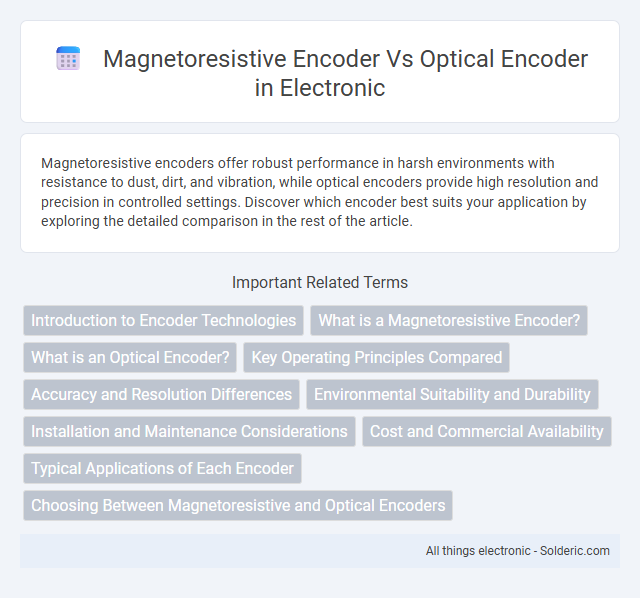Magnetoresistive encoders offer robust performance in harsh environments with resistance to dust, dirt, and vibration, while optical encoders provide high resolution and precision in controlled settings. Discover which encoder best suits your application by exploring the detailed comparison in the rest of the article.
Comparison Table
| Feature | Magnetoresistive Encoder | Optical Encoder |
|---|---|---|
| Operating Principle | Detects magnetic field changes using magnetoresistive sensors | Uses light interruption or reflection to detect position |
| Durability | High resistance to dust, dirt, and vibration | Susceptible to contamination and mechanical wear |
| Accuracy | Moderate to high accuracy, typically up to 20 bits | High accuracy, often exceeding 20 bits resolution |
| Environment Suitability | Ideal for harsh industrial environments | Best suited for clean, controlled environments |
| Size and Integration | Compact and easily integrated into tight spaces | Typically larger due to optical components |
| Cost | Generally lower cost due to simpler construction | Higher cost because of precision optical parts |
| Signal Output | Analog or digital output, less sensitive to signal loss | Digital output with high signal clarity but sensitive to obstructions |
Introduction to Encoder Technologies
Magnetoresistive encoders utilize magnetic fields to detect position changes with high durability and resistance to dust, oil, and vibration, making them ideal for harsh industrial environments. Optical encoders operate based on light interruption or reflection patterns, delivering precise and high-resolution position feedback in cleaner settings. Your choice between these encoder technologies depends on application requirements for environmental robustness and measurement accuracy.
What is a Magnetoresistive Encoder?
A magnetoresistive encoder uses changes in magnetic fields to detect position, providing high durability and resistance to dust, dirt, and moisture compared to optical encoders. This technology relies on magnetoresistive sensors that measure variations in magnetic resistance caused by a magnetic tape or disk to deliver precise positional feedback. Your choice of encoder can significantly impact performance in harsh environments where optical sensors might fail.
What is an Optical Encoder?
An optical encoder is a precise position sensor that uses a light source and photodetector array to read patterns on a rotating disk, converting mechanical motion into digital signals. It excels in high-resolution applications due to its ability to detect minute angular changes with minimal signal noise. Optical encoders are commonly used in robotics, CNC machines, and automation systems for accurate feedback on position and speed.
Key Operating Principles Compared
Magnetoresistive encoders operate by detecting changes in magnetic fields through magnetoresistive sensors that convert magnetic variations into electronic signals, offering high durability in harsh environments. Optical encoders rely on an infrared LED light source and photodetectors to read interruptions or reflections from a patterned disk, providing precise angular position data but with increased sensitivity to dust and contaminants. Understanding these key operating principles helps you choose the encoder type that best suits your application's accuracy requirements and environmental conditions.
Accuracy and Resolution Differences
Magnetoresistive encoders offer superior durability and are less affected by contaminants, but their accuracy typically ranges from 0.1 to 0.5 degrees, with resolution up to 14 bits. Optical encoders provide higher accuracy, often down to 0.01 degrees, and resolutions exceeding 20 bits, making them ideal for precision applications. While magnetoresistive technology excels in harsh environments, optical encoders dominate where ultra-fine accuracy and resolution are critical.
Environmental Suitability and Durability
Magnetoresistive encoders excel in harsh environments due to their resistance to dust, dirt, moisture, and extreme temperatures, making them highly durable for industrial applications. Optical encoders, while offering high resolution, are more susceptible to contamination and mechanical wear, which can degrade performance in dirty or wet conditions. The magnetic sensing technology of magnetoresistive encoders ensures long-term reliability and consistent output under challenging environmental conditions.
Installation and Maintenance Considerations
Magnetoresistive encoders offer easier installation with less sensitivity to dust, dirt, and vibration, reducing alignment challenges common to optical encoders. Optical encoders require clean, precise environments and often need regular cleaning and calibration to maintain accuracy, increasing maintenance efforts. Magnetic encoders' robustness suits harsh industrial settings, minimizing downtime and service costs compared to optical alternatives.
Cost and Commercial Availability
Magnetoresistive encoders generally offer lower cost and higher durability in harsh environments compared to optical encoders, making them more cost-effective for industrial applications. Optical encoders tend to be more expensive due to complex manufacturing processes and the need for precise optical components, but they are widely available in various configurations for high-precision requirements. Both encoder types are commercially available from numerous suppliers, with magnetoresistive encoders gaining traction in applications demanding robust, affordable solutions.
Typical Applications of Each Encoder
Magnetoresistive encoders are commonly used in harsh industrial environments, including robotics, automotive systems, and heavy machinery, due to their durability and resistance to dust, dirt, and moisture. Optical encoders are preferred in precision applications such as CNC machines, printers, and medical devices, where high resolution and accurate position feedback are crucial. When selecting your encoder, consider whether environmental robustness or precise measurement is more critical to your application's success.
Choosing Between Magnetoresistive and Optical Encoders
Choosing between magnetoresistive and optical encoders depends on environmental conditions and application requirements. Magnetoresistive encoders excel in harsh environments with dust, moisture, and vibration due to their robust, contactless sensing technology, while optical encoders deliver higher resolution and accuracy in clean, controlled settings. Cost considerations and maintenance needs also influence selection, with magnetoresistive encoders generally offering longer service life and lower susceptibility to contamination compared to optical encoders.
Magnetoresistive encoder vs optical encoder Infographic

 solderic.com
solderic.com